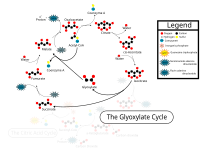Glyoxylate cycle

The glyoxylate cycle is like a special shortcut that some plants and bacteria can use when they need to make energy. Normally, when we eat food, our bodies use a process called the Krebs cycle to turn that food into energy. But certain plants and bacteria don't have access to enough of the things they need to do the Krebs cycle.
So instead they use the glyoxylate cycle. They start by taking a fat molecule (like oil or wax) and converting it into something called an oxaloacetate molecule. Then they add a special enzyme that makes a new molecule called glyoxylate.
Once they have glyoxylate, they can use it to make energy without having to use the Krebs cycle. They take the glyoxylate and some other molecules and turn it into a different molecule called malate. Then they take that malate and some more molecules and turn it into something called succinate. Finally, they can use that succinate to make energy just like we do with the Krebs cycle.
Overall, the glyoxylate cycle is like a clever way for certain plants and bacteria to make energy when they don't have all the things they need for the Krebs cycle.
So instead they use the glyoxylate cycle. They start by taking a fat molecule (like oil or wax) and converting it into something called an oxaloacetate molecule. Then they add a special enzyme that makes a new molecule called glyoxylate.
Once they have glyoxylate, they can use it to make energy without having to use the Krebs cycle. They take the glyoxylate and some other molecules and turn it into a different molecule called malate. Then they take that malate and some more molecules and turn it into something called succinate. Finally, they can use that succinate to make energy just like we do with the Krebs cycle.
Overall, the glyoxylate cycle is like a clever way for certain plants and bacteria to make energy when they don't have all the things they need for the Krebs cycle.
Related topics others have asked about:
